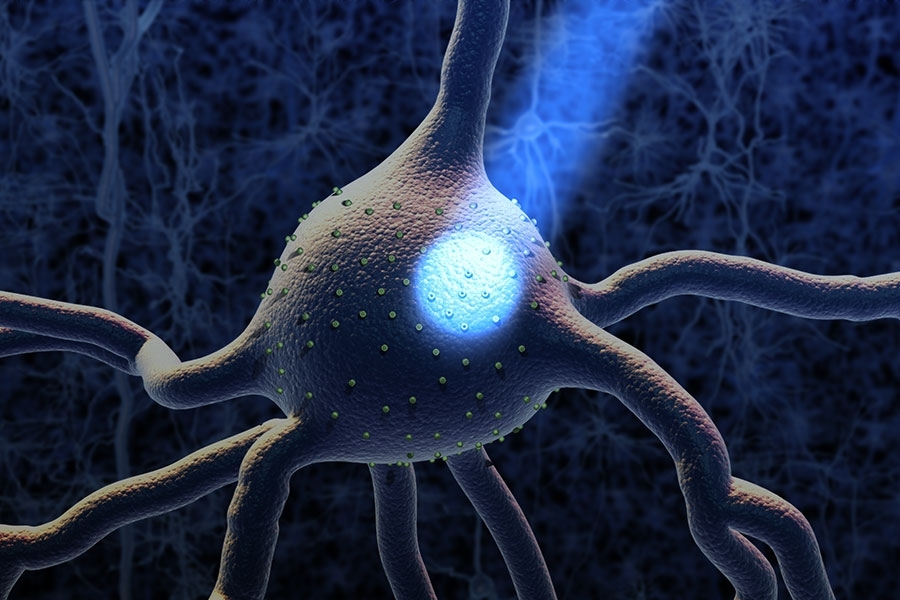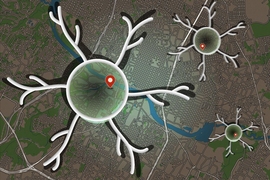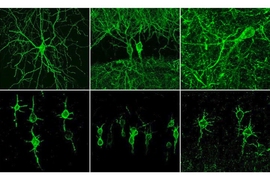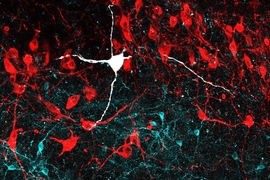Optogenetics has revolutionized neurobiology, allowing researchers to use light to activate or deactivate neurons that are genetically modified to express a light-sensitive channel. This ability to manipulate neuron activity has allowed causal testing of the function of specific neurons, and also has therapeutic potential to reduce symptoms in brain disorders. However, activating neurons deep within a given brain, especially a large primate brain but even a small mouse brain, is challenging, and currently requires implanting fibers that could cause damage or inflammation.
McGovern Investigator Guoping Feng and colleagues have now overcome this challenge, developing optogenetic tools that allow non-invasive stimulation of neurons in the deep brain.
“Neuroscientists have dreamed of methods to turn neurons on and off, to understand the function of different neurons, but also to repair brain malfunctions that lead to psychiatric disorders, and optogenetics made this possible” explains Feng, the James W. (1963) and Patricia T. Poitras Professor in Brain and Cognitive Sciences. “We were trying to improve the light sensitivity of optogenetic tools to broaden applications.”
Engineering with light
In order to stimulate neurons with minimal invasiveness, Feng and colleagues engineered a new type of opsin. The original breakthrough optogenetics protocol used channelrhodopsin, a light-sensitive channel discovered in algae. By expressing this channel in neurons, light of the right wavelength can be used to activate the neuron in a dish or in vivo. However, in vivo application requires the implantation of optical fibers to deliver the light close to the specific brain region being stimulated, especially if the target region is in the deep brain. In addition, if the neuron being targeted is in the deep brain, it is hard for light to reach the region in the absence of invasive tools that can damage tissue and impact the behavior of the animal.
This new study creates a method that can activate any mouse brain region, independent of its location, non-invasively.
“Prior to our study, a few studies have contributed in various ways to the development of optogenetic stimulation methods that would be minimally invasive to the brain. However, all of these studies had various limitations in the extent of brain regions they could activate,” says co-senior study author Robert Desimone, director of the McGovern Institute and the Doris and Don Berkey Professor of Neuroscience at MIT.
Probing the brain with SOUL
Feng and colleagues turned instead to new opsins, in particular SOUL, a new type of opsin that is very sensitive to even low-level light. The Feng group engineered this opsin, based on SSFO, a second-generation optogenetics tool, to have increased light sensitivity, and took advantage of a second property: that SOUL is activated in multiple steps, and once activated, it stays active for longer than other commonly used opsins. This means that a burst of a few seconds of low-level light can cause neurons to stay active for 10-30 minutes.
In order to put SOUL through its paces, the Feng lab expressed this channel in the lateral hypothalamus of the mouse brain. This is a deep region, challenging to reach with light, but with neurons that have clear functions that will lead to changes in behavior. Feng’s group was able to turn on this region non-invasively with light from outside the skull, and cause changes in feeding behavior.
“We were really surprised that SOUL was able to activate one of the deepest areas in the mouse brain, the lateral hypothalamus, which is 6 millimeters deep,” explains Feng.
But there were more surprises. When the authors activated a region of the primate brain using SOUL, they saw oscillations, waves of synchronized neuronal activity coming together like a choir. Such waves are believed to be important for many brain functions, and this result suggests that the new opsin can manipulate these brain waves, allowing scientists to study their role in the brain.
The authors are planning to move the study in several directions, studying models of brain disorders to identify circuits that may be suitable targets for therapy, as well as moving the methodology so that it can be used beyond the superficial cortex in larger animals. While it is too early to discuss applying the system to humans, the research brings us one step closer to future treatment of neurological disorders.









